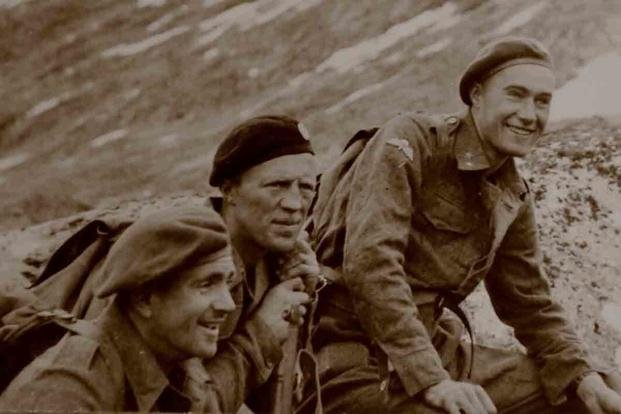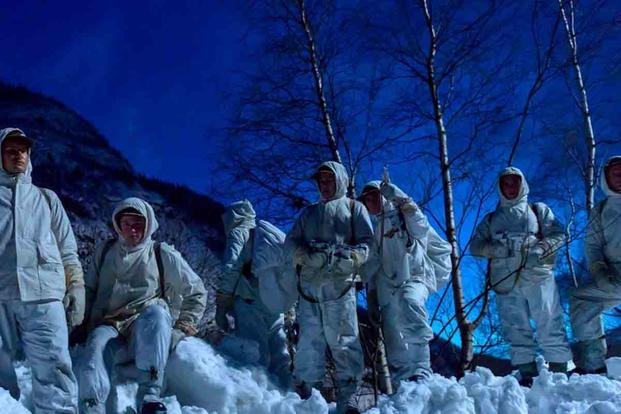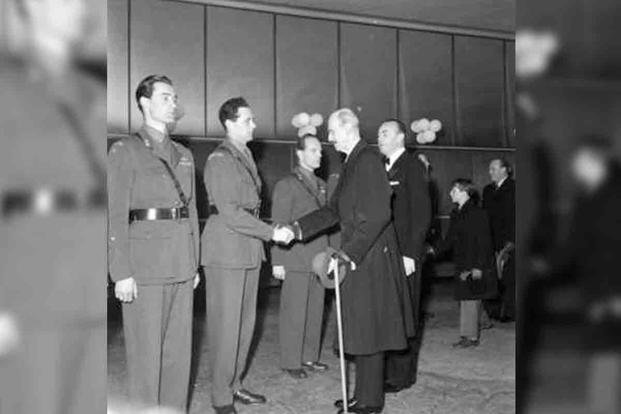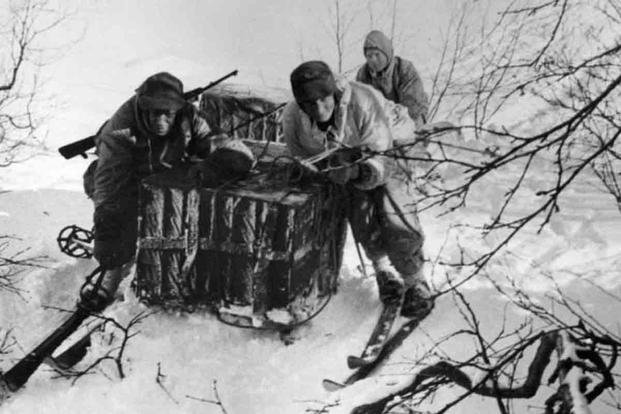As an Amazon associate, Military.com earns from qualifying purchases.
At the start of World War II, Nazi Germany had a long lead in building atomic weapons. It was German scientists who discovered nuclear fission and its energy potential. The United States only began its nuclear program, the Manhattan Project, in earnest when it entered World War II. The U.S. had no idea how far along the Germans were, but assumed the Nazis were pursuing a nuclear weapon as well.
Neither side would end up completing an atomic bomb while the war in Europe raged, but the Allies were determined to stymie Nazi projects at every opportunity. One critical installation to the Nazi atomic bomb effort was the Vemork Norsk Hydro hydrogen electrolysis plant in occupied Norway. Vemork was producing heavy water, a critical component for nuclear chain reactions -- which meant Vemork had to be destroyed.
To neutralize the Vemork plant, the British Special Operations Executive (SOE) would send two gliders filled with commandos into Norway as part of Operation Freshman in November 1942; tragically, those men would be captured, tortured and killed. But in February 1943, the Allies tried yet again to sabotage the Nazi’s atomic bomb effort in a mission known as Operation Gunnerside.
“I was a training officer in sabotage and demolition up in Aviemore before I got the first message from London saying I had been picked to lead an operation in Norway,” Joakhim Ronneberg, the commander of Operation Gunnerside, noted in “Behind the Lines: The Oral History of Special Operations in World War II.” “They never mentioned nuclear weapons, they just mentioned heavy water… They never told me what it was used for.”
Ronneberg would lead Norwegian commandos as they parachuted into the wilderness, skied their way to a hydropower plant, infiltrated the heavily guarded cliffside facility via a ravine, and destroyed its heavy water stockpile. In doing so, they effectively set back Nazi atomic bomb program far enough so the Germans would never be able to build one.

The chain reaction of events that led to Operation Gunnerside actually began five years earlier. In 1938, German chemists Otto Hahn and Fritz Strassmann discovered that bombarding certain elements with neutrons caused them to split. Bombarding uranium, it turned out, would release high amounts of energy when its nucleus was split in two. Physicists Lise Meitner and Otto Robert Frisch figured out what was happening and gave the process a name: nuclear fission.
It didn’t take long before these brilliant scientists figured out the atoms could be split again and again in a chain reaction that, when controlled in a nuclear reactor, could create large amounts of energy. If left uncontrolled, it could be wielded as a destructive weapon.
The problem for the rest of the world was that Hahn and Strassmann worked at the Kaiser Wilhelm Institute in Berlin, which had been under the control of the Nazi regime for nearly five years. In less than a year from their discovery, German Chancellor Adolf Hitler would plunge the continent into a new world war. One of the ways he might win that war was being the first to develop an atomic weapon.
To make such a device, the Nazis had to create a sustained chain reaction. Fission is achieved by bombarding uranium atoms with neutrons, but the neutrons need to be slowed down to make them efficient enough to achieve a critical mass. The substance used to slow neutrons is what’s referred to in nuclear physics as a moderator.
For their moderator, German scientists researched using heavy water, which is different from regular water in that the hydrogen isotope is replaced by deuterium, which makes the substance literally heavier than normal water. While heavy water can be found in nature, it is usually mass-produced for nuclear experimentation and use in nuclear reactors. So when the Allies discovered the Germans were producing heavy water during World War II, they figured it could only mean one thing: The Nazis were trying to build a nuclear bomb.
The Vemork hydrogen electrolysis plant in Norway was the perfect place to create heavy water, which requires a significant amount of energy to produce. The facility was already a hydroelectric power plant, so the Germans could just create and store heavy water there until it was ready to use.

The idea of Hitler having a bomb that could destroy an entire city was not taken lightly in London. To derail the German nuclear program, the British SOE devised a plan that would destroy the Vemork plant. As part of Operation Grouse, the SOE planted an advance team of Norwegian commandos in the nearby wilderness to assess German defenses and guide the commando team to the plant during the next phase of the plan -- except the Grouse commandos didn’t know what the next phase of the plan would be.
SOE then devised Operation Freshman, a force of combat engineers from the British 1st Airborne Division who were to be flown into Norway by two Halifax bombers, each towing two gliders. Once in position, they would assault the front gate of the plant and destroy the facility and its heavy water before escaping overland into Sweden. It would have been the second-longest glider tow ever attempted, if it had succeeded.
On Nov. 19, 1942, the Freshman mission failed to land any troops in the area, as adverse weather downed one of the Halifax tugs and its two gliders. The other Halifax tug lost a glider when its cable snapped, and it was forced to return to base. If there were any survivors of the crashes, they were captured and then likely tortured and executed by the Gestapo.
A new attempt was made when the SOE realized its Grouse personnel were still operational near the Vemork plant. The new operation was codenamed Gunnerside. Instead of sending in glider troops, the Norwegian commandos would parachute into the wilderness and ski to the plant. Once in the area, they would sneak into the plant instead of fighting their way in. By the time the Germans knew they’d been assaulted, the SOE hoped, it would be too late to save the heavy water.
“We had less than three weeks to prepare, to plan our retreat to Sweden, choose the route, get hold of all the maps and intelligence about the target,” said Ronneberg.
The Gunnerside troops faced the same danger as those from Freshman: Hitler’s standing order was that all commandos captured by German troops would be interrogated and killed without remorse. Before the Gunnerside mission began, the Norwegian commander handed out suicide capsules to the men involved.
“I cannot tell you why this mission is so important, but if you succeed, it will live in Norway’s memory for a hundred years,” Norwegian Royal Army Colonel Leif Tronstad reportedly told the commandos at the time, according to “Assault in Norway: Sabotaging the Nazi Nuclear Program.”

The Vemork hydrogen electrolysis plant was a tough nut to crack. It sat on the top of a steep hillside and was surrounded by a deep ravine that acted like a moat, defending its walls. There was one bridge connecting the facility to the rest of the area.
On Feb. 27, 1943, six Norwegians parachuted in to meet the Grouse members who were waiting for them. The 11-man group made their way to the Vemork plant under the cover of extreme weather and crossed the ravine by climbing into it and then up the steep plant walls.
“Conditions were very nice when we landed,” Ronneberg said of the mission in “Behind the Lines.” “But during the day, they just got worse … before night was over, it was a real blizzard.”
For months before the raid, Norwegian resistance operatives had provided the men with maps of the plant, guard positions and routines to allow the members of the commando unit to access Vemork without being detected.
“We left our advance base at about 8 p.m.,” Ronneberg recalled. “We started on skis, but were forced to continue on foot. It was steep country and we sank up to our waists in snow … we began a steep and slippery descent into the river [at the bottom of the ravine] at 10 p.m.” It would be another 2½ hours before the guards’ shift change and the next phase of the operation.
After climbing up a sheer rock face for 150 yards to the Vemork railway line, the commandos waited until the guard moved and then advanced, breaking entry through two locked gates. The commandos entered the building itself through a cable tunnel, but the demolition team had been separated in the search for an entry point. Ronneberg and his partner decided to continue the mission. They took down a guard and entered the heavy water storage room.
“My colleague kept watch over the guard, who seemed frightened but was otherwise quiet and obedient,” said Ronneberg. “I began to place the charges, which went quickly and easily … I had half the charges placed when I heard a crash of broken glass behind me.”
The crash came from the other two members of the demolition team. Unable to find an entrance, they, too, forced their way into the heavy water room. They placed the rest of the charges, double-checked their work and told the guard to run for cover.
“I remember telling him to keep his mouth open, otherwise he would damage his eardrums,” Ronneberg said. “He did, because I spoke to him two years later and his hearing was all right.”
The commandos then left the building, all without firing a shot. The clandestine team was 20 yards from their entry point when the explosions went off. When the sentry at the gate left his post to respond, the Norwegians went back into the night and left the ravine the way they came in. They split up and individually skied to neutral Sweden before heading onto their Norwegian units in Britain. Amazingly, no lives were lost.
Ronneberg and his fellow commandos became international heroes following Operation Gunnerside, with their daring raid celebrated in various media like the 1965 film “The Heroes of Telemark,” starring Kirk Douglas as a fictionalized mission commander. Ronnenberg would become among the most decorated war heroes in Norwegian military history.

While Operation Gunnerside may have delayed Nazi Germany’s heavy water production, it didn’t fully destroy its capabilities. The Nazis resumed heavy water production at Vemork not long after the raid, and the power plant would become the target of many daytime Allied bomber missions for the rest of the war, most having little effect.
The United States would test the first-ever nuclear fission bomb in July 1945, two months after World War II in Europe ended. This test, called Trinity, used readily available graphite as a moderator, instead of heavy water. The U.S. military would quickly develop operational atomic bombs, deploying two against the Japanese cities of Hiroshima and Nagasaki in 1945 and ushering about the end of the war in the Pacific.
“The first time I heard about atom bombs and heavy water was after the Americans dropped the bomb on Hiroshima and Nagasaki,” Ronnenberg recalled in a 2015 profile in The New York Times. “Then we started to understand our raid and why.”
It was only after the war that the Allies learned Germany was never close to building an atomic weapon and had only done preliminary research. But the threat of such a weapon in Hitler’s arsenal was enough to spur the Allies to action, and the raid on Vemork may have set the Nazis back just enough to keep it out of Hitler’s reach.
Ronnenberg, who died in October 2018 at age 99, certainly believed so. Without Operation Gunnerside, he told The New York Times, London could have ended up “looking like Hiroshima.”
Want to Learn More About Military Life?
Whether you're thinking of joining the military, looking for post-military careers or keeping up with military life and benefits, Military.com has you covered. Subscribe to Military.com to have military news, updates and resources delivered directly to your inbox.












